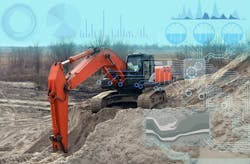9 Strategic Steps to Artificial Intelligence in Fleet Management
Data is the lifeblood of equipment managers who want to better manage and increase the efficiency of their equipment and fleets. The data crucial to accomplishing this task comes from a multitude of internal and external sources that are housed within specific technology databases and software programs.
Check out the quiz below after reading Mike's article.
For decades, equipment managers have been amassing mountains of data. Machine-specific operational performance data; capital and operational cost data; maintenance, repair, and life-cycle data; and a host of other crucial information has been acquired through telematic systems, IoT technologies, and generated through the operation of the fleet. The challenge equipment managers continue to experience lies not only in gathering this data, but also in transforming it into actionable insights that can optimize fleet performance, reduce risk, and reduce costs.
Read also: 10 Ways to Integrate AI into the Specification Process
Time is a precious commodity for equipment managers as they must quickly identify the most critical data to direct the operation of their fleets. They may grapple with identifying which data sets are required to effectively operate their fleets as their priorities evolve over time. They understand that a significant amount of actionable or residual data remains available, essentially enough to extend operational efficiency of the fleet given the time, tools, and resources to utilize it.
Advancements in artificial intelligence (AI) present a game-changing opportunity to revolutionize equipment-management practices. AI-powered systems, equipped with advanced data analytics capabilities, can analyze vast datasets, identify patterns, and generate actionable insights at unprecedented speeds. It will not only address current industry challenges, but it can also potentially propel construction equipment management into a new era of productivity, efficiency, and safety.
Artificial intelligence systems are transitioning from their infancy to more advanced generations (GenAI) having immense data analytic capability. With the speed of such development, they will soon become fully integrated within equipment-management software systems and programs.
How to prepare for AI
Equipment managers and their teams need to prepare before implementing AI in equipment-management systems. Preparation should be strategic and well-planned. Below are nine key steps and considerations to assist in the implementation of AI into equipment management.
1. Clearly define the objectives and goals for implementing AI within the equipment-management systems. Identify specific areas of focus such as predictive maintenance and repair, performance optimization, rightsizing/typing, lease/rent/own decisions, autonomous equipment, safety protocols, and other targeted applications.
Read also: Vetting AI's advice on predictive maintenance
2. Evaluate the availability and quality of data within the organization. This includes equipment specifications; electronic maintenance records; specific machine, vehicle, and equipment operational data; and relevant historical information. It is imperative that all of the targeted data is well-organized, has an extremely high degree of accuracy, and is accessible for AI application implementation.
3. Form a team with diverse skill sets. Include IT professionals, equipment specialists, field operations staff, and the executive branch. This team must remain focused and in sync with each other throughout the process. Collaborate and include external technology providers and others within the industry to remain updated with advancements in AI relevant to the construction equipment sector and leverage this external expertise.
4. Fully automate data collection systems. Data integrity and accuracy are key to successful implementation. Although AI system capabilities will continuously evolve, they analyze all available data to identify commonalities on which to base analytical predictions. AI systems do not identify or correct inaccuracies or gaps within the data, therefore all data utilized should be from automated systems (telematics, GPS, OEM scan, IoT devices, QR codes) having highly defined and integrated reporting parameters. Data utilized that is generated by manual inputs should be heavily scrutinized and must have a stringent quality/accuracy control process before its use.
5. Plan to integrate all data from the various automated sources into a centralized database. The team will need to work closely with the organization’s software providers to integrate available data and AI models into existing systems and workflows. This may involve the development of a customized system interface or a modified version of existing integrations. Further development of specific system integrations to optimize accuracy may be required to ensure that they align with the specific organizational objectives.
6. Initiate pilot projects within the specific objective areas to test the effectiveness of AI implementations in real-world scenarios. Use the results and user feedback for additional fine-tuning and to ensure that the AI applications meet the intended objectives.
7. Scale the implementation over time. Ensure that all applications, the operating system, and system servers are adequate to support the growing volume of data and user interactions. Update as required.
8. Develop a comprehensive training program for end users, equipment operators, and maintenance teams. Ensure that they understand how to interact with and benefit from AI-generated analytics. Clear guidelines and standards are required for accuracy, consistency, and a smoother integration of AI technologies.
9. Establish a monitoring process to gather insights from equipment managers, users, operators, IT, and the executive branch. AI is a tool that equipment managers will utilize to increase efficiency, and everyone within the organization must understand that the responsibility for its accuracy lies within the team itself. Accuracy, quality control, continuous improvements, and continued adaptation are imperative for success.
Equipment managers should stay abreast of technological trends, collaborate with experts, and be prepared to adapt to the evolution of AI integration. Significant accomplishments have already been made in applying AI for tasks like specification development, predictive maintenance, performance optimization, and autonomous operations. Achieving a comprehensive AI integration across all aspects, however, may take several more years. Predicting an exact timeline for when AI will fully realize all the outlined capabilities remains uncertain, yet certainly within the foreseeable future.
By following these steps, equipment managers can strategically and successfully implement artificial intelligence, unlocking the potential for improved efficiency, safety, and innovation in the industry. Each phase of implementation should be approached with a commitment to collaboration, adaptability, and a focus on achieving the defined objectives.
Equipment managers that embrace AI early and invest in its development are likely to realize its potential sooner than others.






